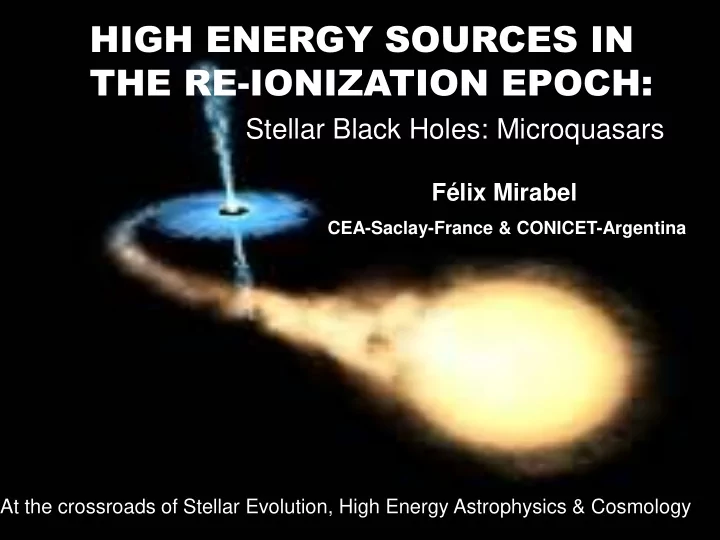

HIGH ENERGY SOURCES IN THE RE-IONIZATION EPOCH: Stellar Black Holes: Microquasars Félix Mirabel CEA-Saclay-France & CONICET-Argentina At the crossroads of Stellar Evolution, High Energy Astrophysics & Cosmology
HOW WAS THE IGM RE-IONIZED? THE « SWISS CHEESE » MODEL for the re-ionization of the IGM: Gunn-Peterson effect • The IGM was fully ionized by the UV Dark age from the first stars (Pop III & II) HII regions expanding at < 100 Km/s. ROLE OF HIGH ENERGY SOURCES (AGN, SNe, LGRBs, XRBs)? • Based on recent results from Stellar evolution and high energy astrophysics: • Proposal: In galaxies at z>10 a large fraction of Pop III-II stars end as HMXBs important feedback in the form of X-rays & jets StBHs StBHs in in HMXBs X-rays overtake the HII regions produced by UVs, heating • and partially ionizing the IGM over large volumes of space.
ASTROPHYSICAL GROUNDS FOR THE STELLAR BLACK HOLE HYPOTHESIS THEORETICAL GROUNDS MOST POP III & II STARS WERE FORMED AS MULTIPLE SYSTEMS • Turk+Science 2009; Krumholz+ Science 2009; Clark+ Science 2011; Stacy+… etc. STARS OF LOW Z WIT WITH H M M > > 20 M 20 M END AS BHs DIRECTLY • Fryer,1999;Heger+2003;Georgy+2009;Woosley+2008;Nomoto+2010; Linden,Kalogera+2011 NO ENERGETIC SNe STELLAR BHs REMAIN BOUND TO D ONORS • Mirabel & Rodrigues, Science 2003; Mirabel+ Nature 2008 OBSERVATIONAL GROUNDS MOST ULXs & LGRBs ARE HOSTED IN LOW Z-HIGH-SSFR GALAXIES • Feng & Soria,2011;LeFloc’h,Duc,Mirabel;2003; Fruchter+ Nature, 2006; But are caveats! Lx/SFR EVOLUTION WITH z IS DRIVEN BY Z EVOLUTION IN HMXBs • Fragos+2012; Basu-Zych+2012 IN LOW Z GALAXIES Lx/SFR IS LARGER THAN IN MAIN-S GALAXIES • Thuan+ 2004; Kaaret+ 2014; Douna, Pellizza, Mirabel, 2014 (in progress)
FROM STUDIES OF HMXBs IN LOCAL UNIVERSE IT IS INFERRED THE COSMIC EVOLUTION OF METALLICITY A COSMIC EVOLUTION OF BH-HMXBs . At low metallicities (Z<Z -5 ) there should be an increase of: • The mass of stellar BHs because the progenitor cores are more massive • The number of BH-HMXBs since massive stars form BHs by direct collapse • The X-ray luminosity of BH-HMXBs …an issue to be investigated further. Mirabel. Invited Review. Proceedings of IAU Symp. 275 (2011) (arXiV:1012.4944v1 [astro-ph.CO] 22 Dec 2010)
Ionization by BH-HMXB vs massive star Mirabel, Dijkstra, Laurent, Loeb, Pritchard (A&A 2011) N&V in Nature (2011) Counting photons 1 M BH 1 1 f esc , BH E N , BH 0.6 N phot f edd t acc f esc ,* , N ,* 64000 M * 0.1 20 Myr keV 0.1 1.0 N phot = number of ionizing photons emitted per atom of H nucleus f edd = fraction of Eddington luminosity for a time t acc <E> = mean photon energy emitted by the accreting BH f esc,* (f esq,BH ) = fraction of ionizing photons that escape For fiducially values of the model parameters: AN ACCRETING STELLAR BLACK HOLE EMITS A NUMBER OF X-RAY PHOTONS COMPARABLE TO THE UV PHOTONS FROM ITS PROGENITOR STAR • But in a fully neutral medium N sec* = 25 (E /1 keV), where E is the photon energy However, not all stars will be massive and lead to the formation of BH- HMXBs…
HMXBs & HI TOMOGRAPHY DURING THE EoR f x at z > 6 must increase as Z < 10 -5 Z Gas Temperature Mirabel+ (2011) l 21cm line Mirabel+ (2011) BH-HMXBs HEATED THE IGM TO ~10 4 K OVER LARGE VOLUMES CONCLUSION: X-RAYS HAVE LONGER MEAN FREE PATH l 21cm line THAN UVs. THEY HEAT THE GAS FAR X-ray hard spectrum FROM THE GALAXIES AND PARTIALLY IONIZE THE BULK OF THE IGM. Fialkov+ Nature, 2014
X-RAY IMPACT ON THE FIRST STARS & GALAXIES THE DOMINANT POP III STARS HAVE MASSES OF 3-30 M • (Hummel, Stacy, Jeon, Oliveri, Bromm, 2014) For n < 1 cm -3 X-ray heating dominates & enhance the formation of H2 For n > 100 cm -3 H2 accelerates cooling, collapse & fragmentation • DWARF GALAXIES WITH <10 10 9 9 M COUL COULD D NO NOT T FORM FORM Mirabel, Dijkstra, Laurent, Loeb, Pritchard (A&A 2011) M min ~ 10 9 ( r/100r c ) -1/2 ( m/0.6) 3/2 [T(K)/10 4 ] 3/2 [(1+ z)/10] -3/2 M r c = critical mass density for a flat universe, r = mass density in the galaxy m = mean molecular weight, z = redshift, T = temperature of the IGM • THE THERMAL HISTORY OF THE IGM DETERMINED BY X-RAYS FROM HMXBs LIMITED THE MASS OF POP III-II STARS & THE NUMBERS OF DWARF GALAXIES RELATIVE TO THE NUMBERS PREDICTED BY THE l CDM
IMPLICATIONS OF THE BH-HMXB HYPOTHESIS I) l 21cm tomography of HI with LOFAR, SKA …may show • a a smoot smoother end t her end to the dar o the dark k ages ges • II) The X-rays from BH-HMXBs may contribute to the 10 10-20 20% % unr unresolv esolved har ed hard X d X-ray ay bac backg kground ound • III) Stellar mass BH-BH binaries may be the more likely detected sour sources ces of of gravita vitational tional waves es (e.g. Belczynski+2011;Ziosi+2014) • IV) Feedback from AGN at the centre of clusters sto stop the unlimited p the unlimited growth of wth of galaxies galaxies (Fabian+) ; feedback from stellar BHs reduce the l CDM predicted number number of of d dwarf arf galaxies galaxies VI) Ther here is e is a a popula population of tion of nak naked ed dar dark ma k matter tter • haloes haloes with M <10 9 M
Recommend
More recommend